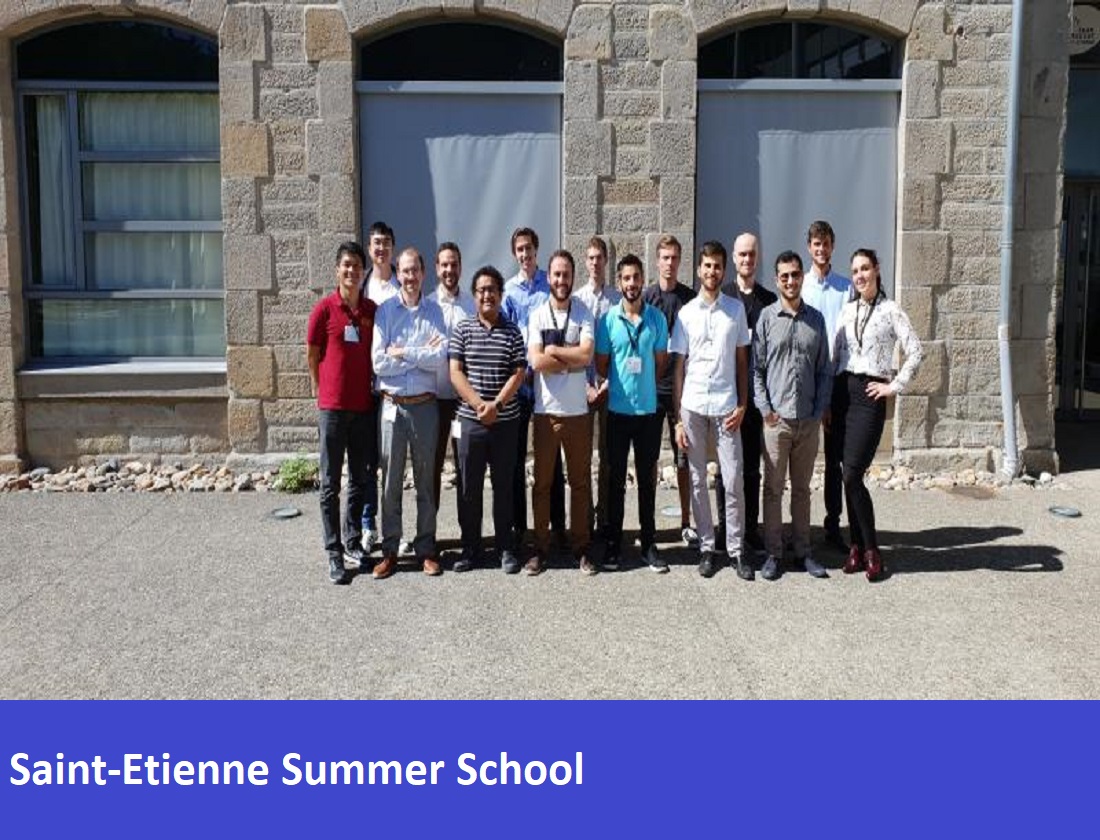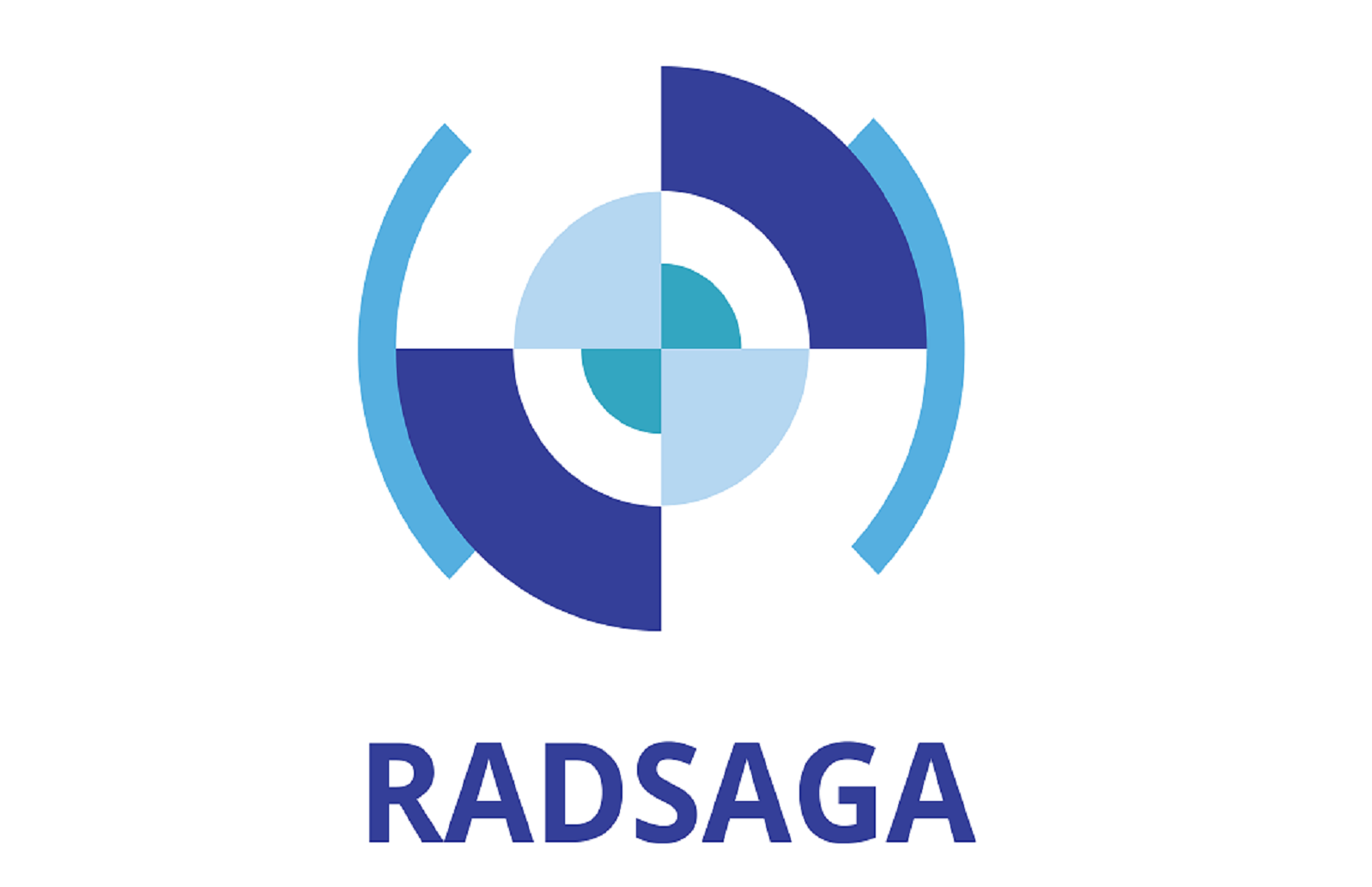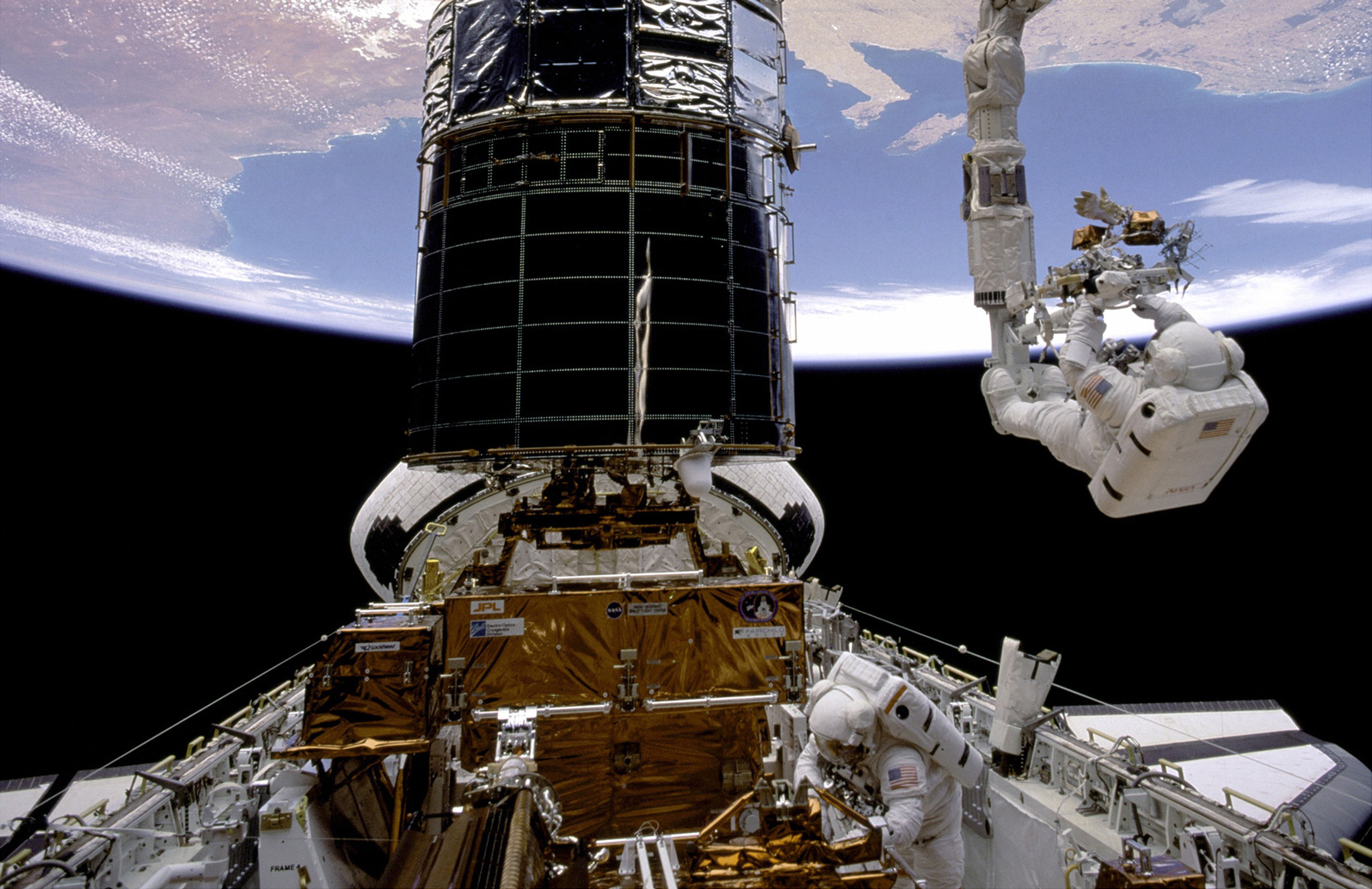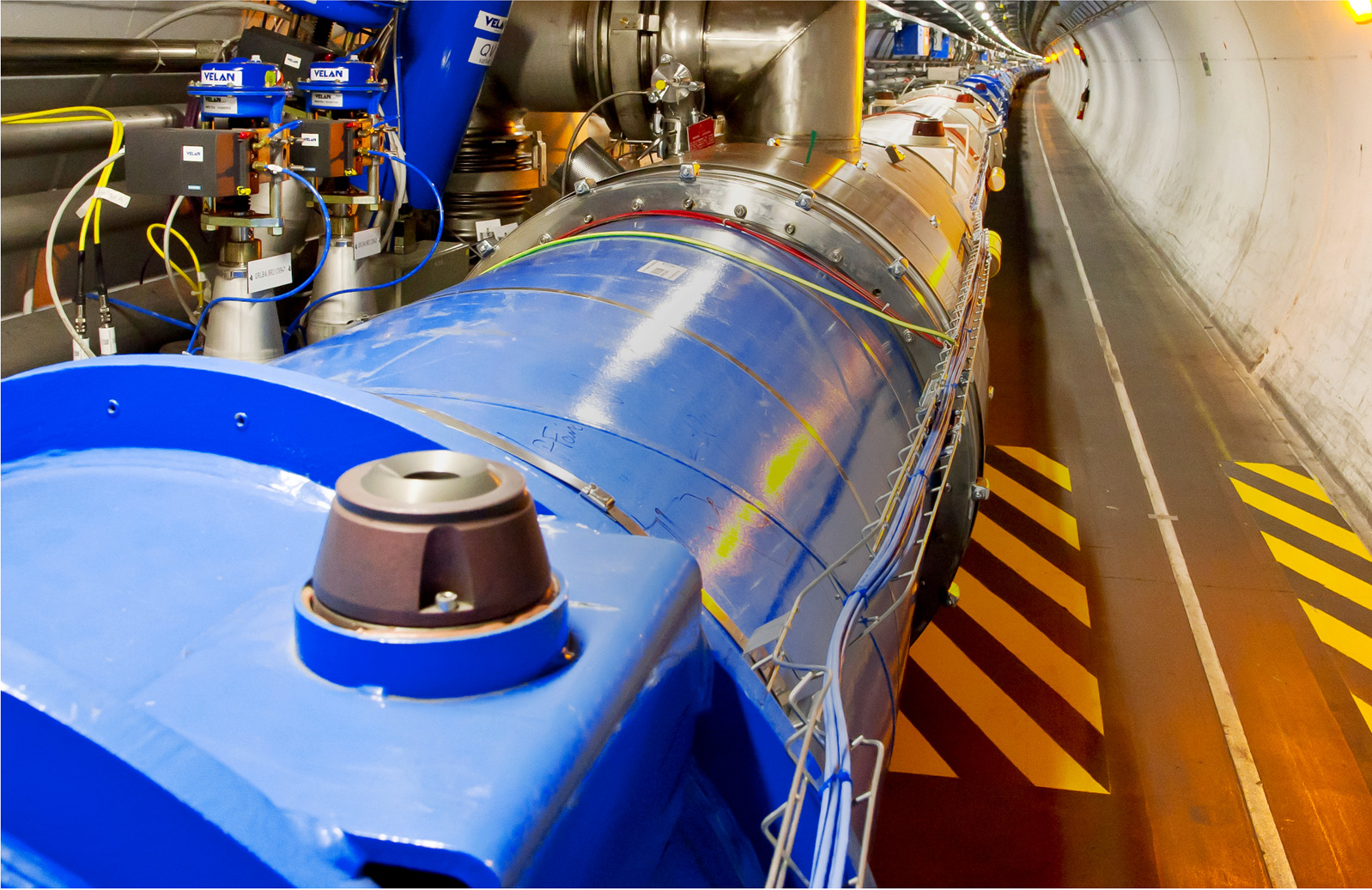Saint-Etienne Summer School
The Saint-Etienne Summer School is the third training event of 2018 which will gather all the ESR students in the RADSAGA training network and will take place from September 10th to September 14th 2018 at the University Jean Monnet in Saint-Etienne, France. Summer school agenda is available here.
This event will mainly features lectures and laboratory experiments. The mid-term review before the European Commission will be held as well on Tuesday 11th and the RADSAGA Supervisory Board on Wednesday 12th.
The agenda of the evelt can be found in the table below:
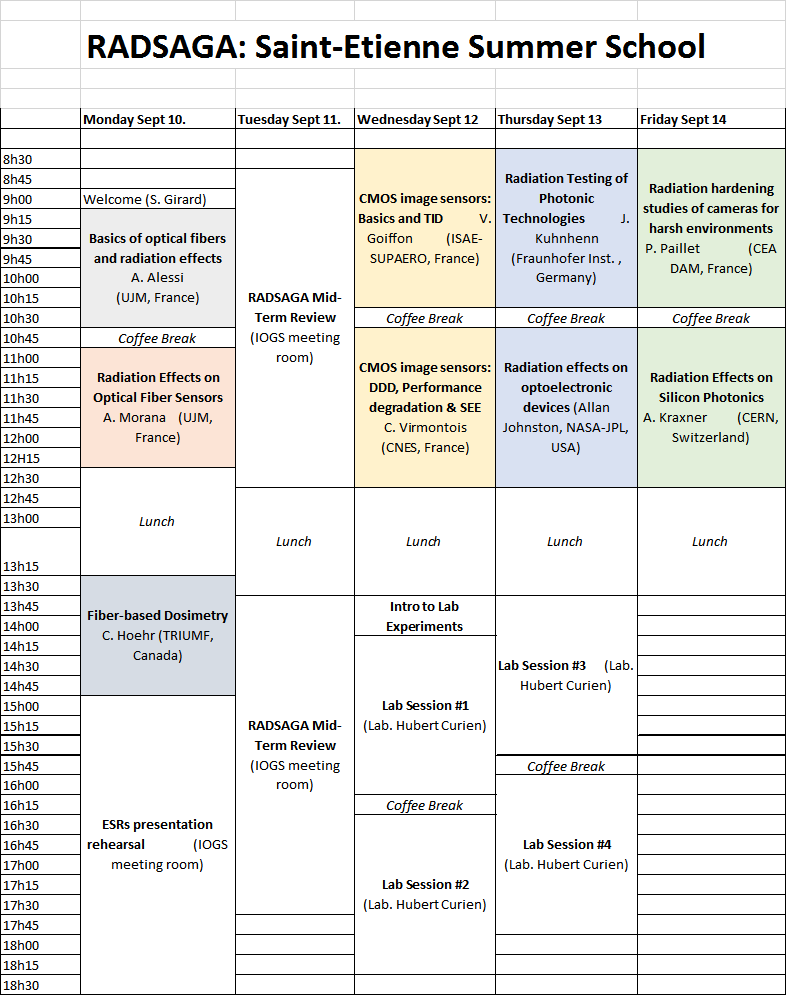
Basics on Optical Fibres and Radiation Effects
Antonino Alessi (UJM, Laboratoire H. Curien, France)
Abstract
This lecture will be focused on the introduction of the principle of operation of the optical fibers as waveguides, their optical properties and on their changes when exposed to various types of radiations. The defect generation and/or conversion as well as the structural modifications impacting the optical features of various types of fibers will be introduced according to the published investigations of the last decades taking in to account basic research and applicative aspect.
Short CV
Antonino Alessi has completed his PhD at the age of 30 years from University of Palermo and postdoctoral studies from University of Palermo and Laboratoire Hubert Curien (Université Jean Monnet). He has published more than 70 papers in reputed journals and he is member of scientific committee of the “International Symposium on SiO2 Advanced Dielectrics and Related Devices”. He is member of the LAMP (Laboratory of Advanced Materials Physics) and MOPERE (Matériaux pour l’Optique et la Photonique en Environnements Radiatifs Extrêmes) research groups and of the EPS (European Physical Society). The main topics of his research activity have been focused, but not limited, on silica based optical fiber, nanoparticles and bulk samples. The impact of radiation and temperature effects on the optical, magnetic and structural properties of such materials have been investigated using different experimental spectroscopic techniques such as optical and IR absorption, luminescence (stationary and time resolved), electro paramagnetic resonance, Raman scattering.
Radiation effects on Optical Fiber Sensors
Adriana Morana (UJM, France)
Abstract
Today, optical fiber sensors (OFSs) are considered for implementation in various nuclear fields, from space applications to the monitoring of next generation nuclear power plants. These technologies present a much higher radiation tolerance level than those of most micro- or opto-electronic technologies. During this lecture, an overview of the most important OFSs will be presented, such as the Fiber Gratings and the distributed sensors based on the light scattering phenomena. In particular, their working principles, features and radiation response will be highlighted.
Short CV
Adriana Morana received her Master's degree in Physics from University of Palermo in Italy in 2010. After, in 2013, she received her Ph.D. degree in Optics, Photonics and Hyperfrequencies from the University Jean Monnet of Saint Etienne (France) and the University of Palermo (Italy), thanks to a cotutelle and a strong collaboration between the two institutes. The results of her Ph.D. led to a new manufacturing method of optical fiber sensors resistant to harsh environments mixing ionizing or not radiation and extreme temperatures. Since then, the several post-doctoral positions she had at the Laboratoire Hubert Curien allowed her to continue her research on the optical fiber sensors and their radiation effects for several applications, such as nuclear power plants, nuclear waste repositories, ITER and also dosimetry. She authored or co-authored several papers in almost 10 different journals. Her work in harsh environments led also to contributions at the IEEE Nuclear and Space Radiation Effects Conference (NSREC) and the Radiations Effects on Components and Systems (RADECS) conferences. She is the recipient of the 2017 Paul Phelps Award from the IEEE Nuclear and Plasma Sciences Society.
Fiber-Based Dosimetry
Cornelia Hoehr (TRIUMF, Canada)
Abstract
This lecture will introduce fiber detectors in medical physics application. In radiation therapy it is important to have accurate treatment beam measurements that can be used for the patient treatment planning. The needs and wants of detectors for dosimetry in radiation therapy will be introduced, and the shortcomings of available and commonly used detectors will be discussed. On this background, fiber detectors will be compared and the changes that they can bring to radiation therapy will be examined.
Short CV
Cornelia Hoehr received her Ph.D. in atomic physics from Heidelberg University in Germany and the Max-Plank institute for Nuclear Physics in Heidelberg in 2004, after completing a Masters in physics at Freiburg University in Germany. After a post-doctoral research term at the Argonne National Lab, USA, she then moved to TRIUMF as a post-doctoral researcher, and subsequently took on roles in operation and facilities in isotope production and proton therapy. In 2013 she became a research scientist at TRIUMF and an Adjunct Professor at the University of Victoria, and in 2018 she took over the role as Deputy Associated Laboratory Director – Life Sciences. Her research interests are focused on medical isotope production and proton therapy. She is a member of the steering committee for the Particle Therapy Co-Operative Group (PTCOG), consultant to the IAEA in isotope production, and was chair of the TRIUMF User Group Executive Committee (TUEC).
CMOS Image Sensors: Technology Overview and Total Ionizing Dose Effects
Vincent GOIFFON (ISAE SUPAERO, France)
Abstract
Today, CMOS Image Sensors (CIS), also called Active Pixel Sensors (APS), are the most popular solid state imager technology. In particular, CISs are used in various imaging applications in harsh radiation environments (e.g. space remote sensing). During this lecture, the particularities of the CIS technology will be briefly presented as well as the basic principles of these CMOS integrated circuits. In a second part, an overview of the most important total ionizing dose effects on this technology will be discussed.
Short CV
Vincent Goiffon received the Master's degree in Electrical Engineering and the Master's degree in Aerospace Engineering (Diplôme d'Ingénieur SUPAERO) both from SUPAERO, Toulouse, France, in 2005. He received his Ph.D. degree in Electrical Engineering from the University of Toulouse in 2008. He has been an Associate Professor at ISAE-SUPAERO from January 2009 to August 2018. He his now a Full Professor in the Institute. His research interests focus on solid-state image sensors and include CMOS integrated circuit design, pixel/device modeling/simulation/characterization, leakage/dark current, Random Telegraph Signals (RTS), radiation effects and hardening-by-design techniques. Besides his regular participation to R&D projects for space applications, he is currently responsible for the development of a radiation hard image sensor demonstrator for ITER remote handling applications and for the development of a radiation hard inspection camera prototype for nuclear power plant dismantling and nuclear waste management. He is also taking part in CEA vulnerability studies for the development of radiation hard plasma diagnostics for inertial confinement fusion experiments in Megajoule class laser facilities (i.e. the Laser MegaJoule and the National Ignition Facility). Vincent Goiffon has authored or co-authored one book chapter and more than 60 journal papers, including one NSREC Outstanding Conference Paper Award and four Outstanding Student Paper Awards (at the IEEE Nuclear and Space Radiation Effects Conference (NSREC) and the Radiations Effects on Components and Systems (RADECS) conference).
CMOS Image Sensors - DDD, Performance Degradation & SEE
Cédric Virmontois (CNES, France)
Abstract
Today, CMOS Image Sensors (CIS), are more and more used for space missions. Thanks to their high performances, low power consumption and the possibility to integrate numerous functions, the CIS equals the other visible technologies as Charge Coupled Devices (CCD). During this lecture, the first part will be dedicated to the displacement damage dose effects on CIS. The second part will be focused on the impact of radiation at the space instrument levels and the mitigation techniques adopted.
Short CV
Cédric Virmontois (S’10–M’12) received the Engineering degree in Physics from the Institut National des Sciences Appliquées (INSA) of Toulouse in 2008 and the Ph.D. degree in Microelectronic from the Institut Supérieur de l’Aéronautique et de l’Espace (ISAE Supaero) of Toulouse in 2012. His Ph.D. research focused on displacement damage-induced degradation effects in CMOS image sensors. He modeled the degradation of the sensor parameter of performances, especially the dark current and it associated random telegraph signal and he deduced hardening-by-design techniques to mitigate space radiation effects in CMOS imagers. Cedric presently works for the Centre National d’Études Spatiales (CNES) in Toulouse, France, as Detection Chain Architect in the Payload and Imaging Division. His work involves the development of imagers for future space missions, electro-optical characterizations, analysis and testing of imagers and he is responsible for the technology watch on image sensors. Today, he extends his researches to several solid state imagers using ground and in-flight data in order to find generic ways to predict and mitigate space radiation effects. Cedric has served the radiation effects community as reviewer for the IEEE Nuclear and Space Radiation Effects Conference (NSREC) and for publications in the IEEE Transactions on Nuclear Science. He has authored or co-authored more than 30 papers in refereed journals, including the NSREC 2011 Outstanding Student Paper Award the NSREC 2012 Outstanding Conference Paper Award. He also received the IEEE NPSS Phelps Award as a student in 2012. He is a Member of the IEEE and a Member of the NPSS and the EDS.
Radiation Effects on Optoelectronic Devices
Lecturer: Allan Johnston (NASA-JPL, USA)
Abstract
This talk begins with a short discussion of the physical principles involved in light emission and absorption in semiconductors. This includes “bandgap engineering”, as well as the properties of several material technologies that are of interest in optoelectronics. The basic operation of light-emitting diodes and laser diodes is reviewed, emphasizing design features that are important in determining radiation damage sensitivity.
The next section discusses the principles involved in radiation damage, with the main emphasis on displacement damage. This includes methods to compare damage from different types of particles, as well as the complications of different types of microscopic damage structures and annealing.
The last part of the course discusses damage in specific types of devices, along with tradeoffs between reliability and radiation damage sensitivity. Examples are shown where degradation of optoelectronic devices has affected operational spacecraft.
Short CV
Allan Johnston received B. S. and M. S. degrees in physics from the University of Washington in Seattle. He joined Boeing Aerospace in 1965, where he carried out research studies on radiation effects in microelectronics for military and space applications, including work on total dose effects in MOS devices, latchup, and laser simulation.
In 1992 he joined the Caltech Jet Propulsion Laboratory, supporting numerous NASA space programs, as well as leading research efforts in radiation effects on microelectronics and optoelectronics at JPL. His technical interests include optoelectronics, single-event upset in microelectronics, low dose-rate effects, latchup, and radiation effects in highly scaled devices. He retired from JPL in 2013.
He was Technical Chair of the IEEE Nuclear and Space Radiation Effects Conference (NSREC) in 1997, and General Chair in 2003. He received NSREC Meritorious Paper awards in 1984 and 1986, and the Outstanding Paper award in 1999. He has published more than 100 papers, two book chapters, and authored a book, Reliability and Radiation Effects in Compound Semiconductors, published by World Scientific in 2010. He has given short courses on radiation effects at the NSREC, IRPS, and the European RADECS Conferences. He is a Fellow of the IEEE, and is currently Chair of the Radiation Effects Committee of the NPSS AdCom that oversees NSREC conferences.
Radiation Hardening Studies of Cameras for Harsh Environment
Lecturer: Philippe Paillet (CEA DAM, France)
Abstract
In a practical application, the complete system in use is made of several sub-parts, each presenting its own radiation sensitivity challenges. The example here of a camera can be divided into 3 main sub-parts: The image sensor (detector), the Optical system (made of glass lenses to transport the image to the sensor) and the illumination system (made of light emitting technologies to provide the required photons to the scene being recorded). The radiation hardening of each of these sub-parts is investigated separately at the device level, then combined with hardening strategies at the system level to design cameras able to work in harsh radiation environments. During this lecture, an overview of two applications using cameras will be presented: one for a camera to be used for plasma diagnostics in a Nuclear Fusion experiment (at the Laser MegaJoule or the National Ignition Facility), the other for the monitoring of radioactive materials during maintenance or storage.
Short CV
Philippe Paillet received his Master's degree in Electrical Engineering from the Université Aix-Marseille I, France, in 1989 and his PhD degree in Electrical Engineering from the Université Montpellier II, France, in 1995. He joined the Commissariat à l'Energie Atomique (CEA) in Arpajon, France, in 1995 and is an international expert, senior member of the technical staff and project manager. Philippe has been involved in numerous programs developing radiation-hardened electronic and optoelectronic technologies, characterizing the physical mechanisms responsible for radiation response of components and ICs, modeling the effects of radiation in MOS technologies and the creation of radiation-induced defects, and developing hardness assurance approaches. He is also leading CEA vulnerability studies for the development of radiation hard plasma diagnostics for inertial confinement fusion experiments in Megajoule class laser facilities (i.e. the Laser MegaJoule and the National Ignition Facility).
Philippe has served the radiation effects community as reviewer and Session Chairman for the IEEE Nuclear and Space Radiation Effects Conference (NSREC) and the RADiation Effects in Components and Systems (RADECS) European conference. He serves as Associate Editor for IEEE Transactions on Nuclear Science. He has authored or co-authored more than 200 publications, articles, short courses and book chapters, including two Best Papers at RADECS, two Meritorious Paper Awards at NSREC, one Best Paper Award at HEART, and five Outstanding Paper Awards at NSREC. He is currently serving as Associate Editor for the scientific journal IEEE Transactions on Nuclear Science. He is also Vice-president of the RADECS Association (the Steering Group of RADECS Conferences) and RADECS Liaison to the IEEE Radiation Effects Steering Group.
Radiation Effects on Silicon Photonics
Lecturer: A. Kraxner (CERN, CH)
Abstract
We will first cover the basics of what Silicon Photonics is and how this rather new technology could find applications in radiation environments, with a focus of high-energy physics experiments. We will then move on the main topic that is the effect of radiation on the main building blocks of a Silicon Photonics optical link - the Modulators and Photodiodes. The challenge of understanding the radiation effects through both experimental radiation hardness testing and simulation will be highlighted, and we will show how radiation tolerance can be improved by design and/or choice of operating parameters. Finally we will discuss the remaining opportunities and challenges of this rather new research topic.
Short CV
Andrea Kraxner is part of the team developing optical links in the Electronic Systems for the Experiments group at CERN. Her focus lies in the investigation of the applicability of Silicon Photonics as optical links for LHC upgrades and for future High Energy Physics experiments. She received her Master in Advanced Materials Sciences with the focus on Semiconductor Processing and Nanotechnology and her PhD in Technical Physics from the Graz University of Technology, Austria. During her Master project and PhD she worked in the TCAD and Device R&D group at ams AG with a focus on optoelectronic semiconductor devices.
Laboratory experiments
- Dosimetry with optical fibers: radioluminescence under X-rays, dose rate influence, temperature influence;
- Image sensors;
- Distributed fiber sensors: tests of various technologies, strain and temperature measurements;
- Punctual fiber sensors: fabrication of a Fiber Bragg Grating (UV laser on fiber) and testing.
